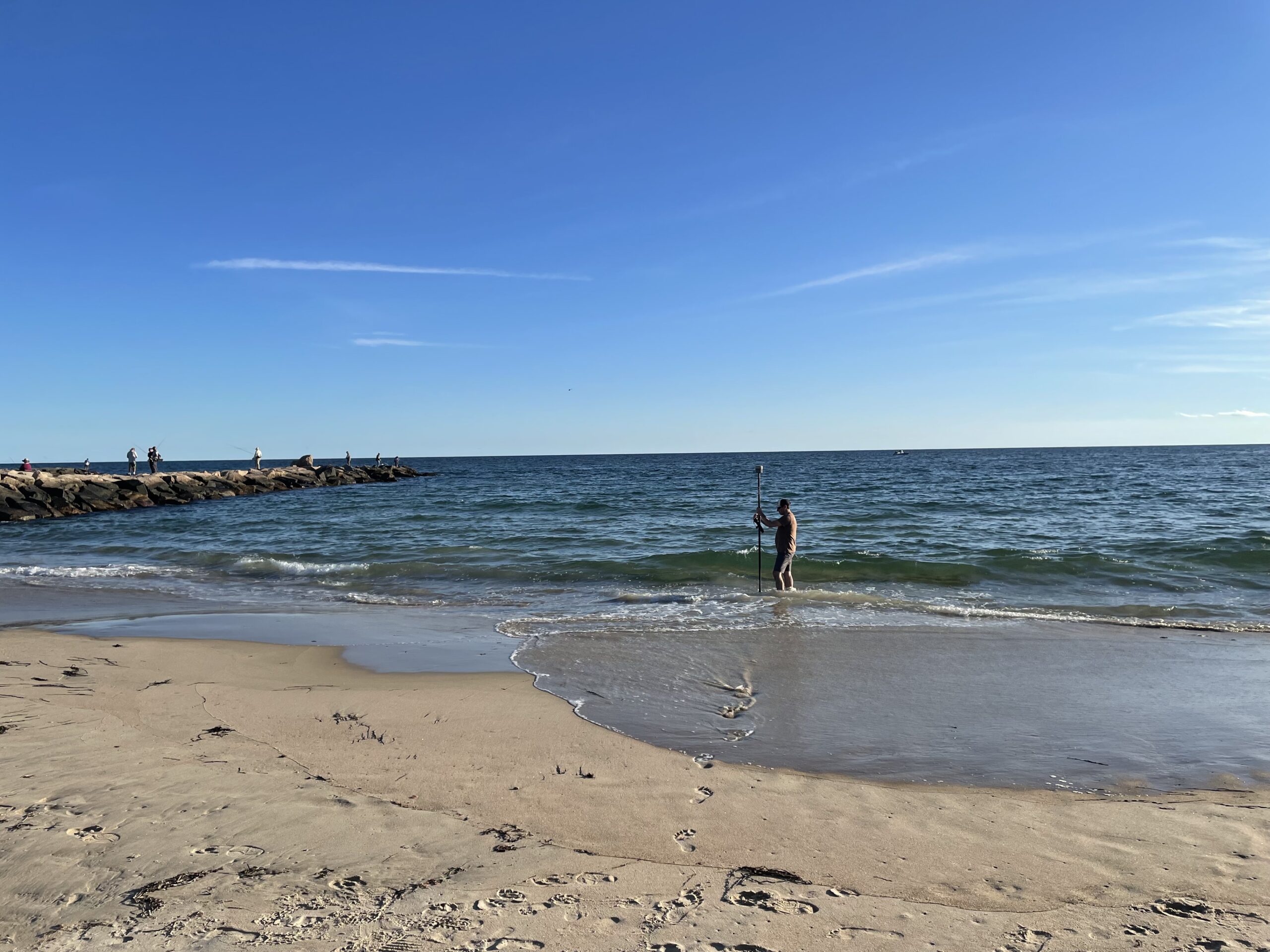Walking Tour Illustrates the Difficulty in Accessing the Ocean State’s Public Shoreline
By Cynthia Drummond / ecoRI News contributor
 |
| Janet Freedman of URI’s Coastal Institute points out the features of a well- marked shoreline access right of way on Atlantic Avenue in Westerly. (Cynthia Drummond/ecoRI News) |
On a clear September afternoon, a group of about 30 people gathered at
the Weekapaug Breachway on Atlantic Avenue for a walking tour of Westerly’s
shoreline public access points.
Leading
the walking tour were Janet Freedman and Nathan
Vinhateiro of the University of Rhode Island’s Coastal
Institute, who have been documenting the dynamic nature of beaches, tides and
tide lines.
Additional
tour leaders were Christine Dudley, the
DEM’s deputy chief of freshwater and diadromous fisheries; Leah Feldman and
Laura Dwyer of the Coastal Resources Management Council;
representatives from Rhode Island Sea Grant;
Casey Tremper of Clean Ocean Access;
and state Rep. Terri Cortvriend, D-Portsmouth and
Middletown, who chaired the special legislative commission studying public
shoreline access.
An
issue that has elicited some of the strongest public engagement in Rhode Island
in recent years, access to the shoreline in coastal towns, including Westerly,
has been the subject of in-depth coverage by ecoRI News.
The
relatively clear language in the Rhode Island Constitution affirms
the public’s right to the shoreline; however, beach erosion and disputes over
who can access what is left of the shoreline have rendered the issue anything
but simple.
The
jurisdictional complexity of the issue was obvious from the beginning of the
tour when, in order to walk to Dunes Park beach, the group used a fishing
access right of way owned by the Rhode Island Department of Environmental
Management (DEM).
The
DEM’s Dudley explained that in the case of the Weekapaug Breachway, anglers who
pay to fish there should receive priority access, including parking, which is
often at a premium in the tiny adjacent lot.
“Our
mantra is ‘user pay, user benefit,’” she said. “The people that pay benefit.
The anglers pay for it and voters, in some cases, in some of our areas, they
pay for it, they should be able to access these areas … What is hard for us is,
in the summer, if the parking lots are filled with people just going to the
beach.”
Lawmakers have been considering a recent proposal to use the wrack, or debris line, to determine where the public can cross the beach.
 |
| URI Coastal Institute researcher Nathan Vinhateiro holds a surveyors’ tool used for measuring the tides. (Cynthia Drummond/ecoRI News) |
Vinhateiro
discussed the details of a research project which began about a year ago to
record tidal data on Rhode Island’s beaches.
Determining
the long-term average of high tides, he explained, does not account for
processes such as wave action on natural, sandy beaches, which are constantly
shifting.
“It’s
invisible,” he said. “Nobody knows where it is. It changes every day, because
the shape of the beach changes.”
Freedman,
who, with Vinhateiro, does a monthly tidal survey, said the team uses
surveyors’ equipment to measure the elevation of the mean high water line and
where it intersects the shoreline.
“Once
we have that in place, we would take a measurement every five minutes and take
the furthest wave height that’s in that five-minute time, and do this for
several hours around the low tide line,” she said.
Tides,
Freedman added, are the principal factors determining how much beach the public
can legally access.
“We
found that you have access to the beach, you know, maybe at low tide, maybe a
couple of hours either side of low tide,” she said, adding “… I would like to
point out, too, I think we’re all technically trespassing.”
Cortvriend
said the members of the legislative commission had reached a consensus on a
public access bill that passed in the House but never reached the Senate.
“It
did not go the decriminalizing trespassing route,” she said. “The legislation
that was passed by the House was six feet above the most recent, visible high
tide line, so in the wintertime you wouldn’t get your feet wet if you happened
to be out here at high tide. And, that was passed by the House, but sadly, the
Senate chose not to take the bill up.”
Cortvriend
said she intended to introduce the bill in the next legislative session.
Freedman
underscored the dynamic nature of the high tide line.
“The
area [of the beach] that you’ll be able to use is going to change all the time,
so today, where we have a particularly low high tide that’s here, or at that
stake, would be six feet from it, but on days when you might have a higher or
spring high tide with a full moon, or a new moon, it would be further up the
beach, so, it’s a changing line,” she said.
The
group left the beach and began walking along Atlantic Avenue, looking for
public rights of way. There are about 230 CRMC-designated rights of way in
Rhode Island, including several in Westerly, all of which are documented in
an online map.
CRMC
policy analyst Leah Feldman said the rights of way varied widely in their
accessibility.
“We’re
going to stop at a couple of CRMC-designated rights of way along the way. They
will be different, visually different for you all to see, for a number of
reasons,” she said.
The
group stopped in front of a right of way that was practically invisible.
“These
rights of way were laid out in 1909, when they divided this plat into different
beach lots,” Freedman said. “There used to be a trolley line that would come
here and there was public access onto the shore every few hundred feet or
something, along Atlantic Avenue. It’s officially a CRMC right of way, so this
is legally a right of way, but if you can see here, there’s definitely some
issues with clearing it and opening it up to the public.”
While
it has been designated by the CRMC, the right of way is owned by the town,
which would encounter several issues if it ever re-opened the path. Those
include a wetland at the Atlantic Avenue end which would require a boardwalk,
and a revetment, or fortification, on the beach side.
“I
think they would take a lot of convincing to take on the expenses of that,”
Freedman said.
 |
| This CRMC-designated right of way in Westerly is completely obscured by overgrown vegetation. The town owns the pathway. (Cynthia Drummond/ecoRI News) |
At
a second designated right of way, the path to the beach was also blocked by
overgrown vegetation. Finally, with its own painted crosswalk across Atlantic
Avenue, here was an open, clearly-marked right of way, denoted by a sign and a
granite marker.
But
there was a catch: while this is an obvious, usable public path to the beach,
there’s no place for visitors to park.
“There’s
no parking, but other than that, it’s not bad,” Freedman said.
Several
interested homeowners joined the walk to try to learn more about the
designation process. One woman wanted to know how a right of way shared by a
small group of homeowners could suddenly be expanded to become public.
Tamara
Tarpinian-Jachym owns a home in Westerly, one of seven properties with a deeded
right of way to the beach that dates back to 1928.
“I
had a deeded access to the ocean beach from that right of way on Maplewood and
Atlantic Avenue,” she said. “[In] 2015, the town and GIS mapping, they took it.
They said ‘That’s the right of way now.’ So, my question is, a lot of these
deeds go way back. How do people just get thrown off a deed for access?”
Bill
and Linda Young, who own a home at Scarborough Beach in Narragansett, said they
also hoped to learn more about the right of way issue.
“Just
general interest in how this stuff gets done,” Linda Young said, “Because I
know there’s stuff going on in Narragansett. I just kind of like to see what’s
going on in different towns.”
Bill
Young added, “To understand more, but I’ve always had a question about the mean
high tide line and I thought that the right of way had changed in the legislature,
but, as I found out … the House passed it but the Senate didn’t.”